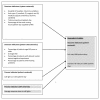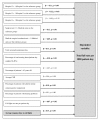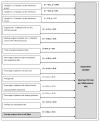The contribution of staff call light response time to fall and injurious fall rates: an exploratory study in four US hospitals using archived hospital data
- PMID: 22462485
- PMCID: PMC3364911
- DOI: 10.1186/1472-6963-12-84
The contribution of staff call light response time to fall and injurious fall rates: an exploratory study in four US hospitals using archived hospital data
Abstract
Background: Fall prevention programs for hospitalized patients have had limited success, and the effect of programs on decreasing total falls and fall-related injuries is still inconclusive. This exploratory multi-hospital study examined the unique contribution of call light response time to predicting total fall rates and injurious fall rates in inpatient acute care settings. The conceptual model was based on Donabedian's framework of structure, process, and health-care outcomes. The covariates included the hospital, unit type, total nursing hours per patient-day (HPPDs), percentage of the total nursing HPPDs supplied by registered nurses, percentage of patients aged 65 years or older, average case mix index, percentage of patients with altered mental status, percentage of patients with hearing problems, and call light use rate per patient-day.
Methods: We analyzed data from 28 units from 4 Michigan hospitals, using archived data and chart reviews from January 2004 to May 2009. The patient care unit-month, defined as data aggregated by month for each patient care unit, was the unit of analysis (N = 1063). Hierarchical multiple regression analyses were used.
Results: Faster call light response time was associated with lower total fall and injurious fall rates. Units with a higher call light use rate had lower total fall and injurious fall rates. A higher percentage of productive nursing hours provided by registered nurses was associated with lower total fall and injurious fall rates. A higher percentage of patients with altered mental status was associated with a higher total fall rate but not a higher injurious fall rate. Units with a higher percentage of patients aged 65 years or older had lower injurious fall rates.
Conclusions: Faster call light response time appeared to contribute to lower total fall and injurious fall rates, after controlling for the covariates. For practical relevance, hospital and nursing executives should consider strategizing fall and injurious fall prevention efforts by aiming for a decrease in staff response time to call lights. Monitoring call light response time on a regular basis is recommended and could be incorporated into evidence-based practice guidelines for fall prevention.
Figures



Similar articles
-
Relationship between call light use and response time and inpatient falls in acute care settings.J Clin Nurs. 2009 Dec;18(23):3333-41. doi: 10.1111/j.1365-2702.2009.02916.x. Epub 2009 Sep 4. J Clin Nurs. 2009. PMID: 19735337
-
Unit-level time trends in inpatient fall rates of US hospitals.Med Care. 2012 Sep;50(9):801-7. doi: 10.1097/MLR.0b013e31825a8b88. Med Care. 2012. PMID: 22889804
-
Are call light use and response time correlated with inpatient falls and inpatient dissatisfaction?J Nurs Care Qual. 2009 Jul-Sep;24(3):232-42. doi: 10.1097/NCQ.0b013e3181955f30. J Nurs Care Qual. 2009. PMID: 19525764
-
Older adults' perceptions of their fall risk in the hospital: An integrative review.J Clin Nurs. 2022 Sep;31(17-18):2418-2436. doi: 10.1111/jocn.16125. Epub 2021 Nov 16. J Clin Nurs. 2022. PMID: 34786777 Review.
-
Fall Prevention and Injury Reduction Utilizing Virtual Sitters in Hospitalized Patients: A Literature Review.Comput Inform Nurs. 2021 May 28;39(12):929-934. doi: 10.1097/CIN.0000000000000773. Comput Inform Nurs. 2021. PMID: 34050057 Review.
Cited by
-
Factors Driving Patient Perception of Quality Care After Primary Total Hip and Total Knee Arthroplasty.J Am Acad Orthop Surg Glob Res Rev. 2018 Nov 8;2(11):e061. doi: 10.5435/JAAOSGlobal-D-18-00061. eCollection 2018 Nov. J Am Acad Orthop Surg Glob Res Rev. 2018. PMID: 30656258 Free PMC article.
-
Patient-level and organizational-level factors influencing in-hospital falls.J Adv Nurs. 2022 Nov;78(11):3641-3651. doi: 10.1111/jan.15254. Epub 2022 Apr 20. J Adv Nurs. 2022. PMID: 35441709 Free PMC article.
-
Impact of Inpatient Unit Design Features on Overall Patient Experience and Perceived Room-Level Call Button Response.Int J Environ Res Public Health. 2021 Sep 16;18(18):9747. doi: 10.3390/ijerph18189747. Int J Environ Res Public Health. 2021. PMID: 34574672 Free PMC article.
-
Perspectives of Nurses and Patients on Call Light Technology.Comput Inform Nurs. 2015 Aug;33(8):359-67. doi: 10.1097/CIN.0000000000000177. Comput Inform Nurs. 2015. PMID: 26176639 Free PMC article.
-
REFINE (REducing Falls in In-patieNt Elderly) using bed and bedside chair pressure sensors linked to radio-pagers in acute hospital care: a randomised controlled trial.Age Ageing. 2014 Mar;43(2):247-53. doi: 10.1093/ageing/aft155. Epub 2013 Oct 18. Age Ageing. 2014. PMID: 24141253 Free PMC article. Clinical Trial.
References
-
- Cameron ID, Murray GR, Gillespie LD, Robertson MC, Hill KD, Cumming RG, Kerse N. Interventions for preventing falls in older people in nursing care facilities and hospitals. Cochrane Database Syst Rev. 2010;1:CD005465. - PubMed
-
- Oliver D, Connelly JB, Victor CR, Shaw FE, Whitehead A, Genc Y, Vanoli A, Martin FC, Gosney MA. Strategies to prevent falls and fractures in hospitals and care homes and effect of cognitive impairment: systematic review and meta-analyses. BMJ. 2007;334(7584):82. doi: 10.1136/bmj.39049.706493.55. - DOI - PMC - PubMed
-
- Raeder K, Siegmund U, Grittner U, Dassen T, Heinze C. The use of fall prevention guidelines in German hospitals--a multilevel analysis. J Eval Clin Pract. 2010;16(3):464–469. - PubMed
Publication types
MeSH terms
Grants and funding
LinkOut - more resources
Full Text Sources
Medical
Miscellaneous

